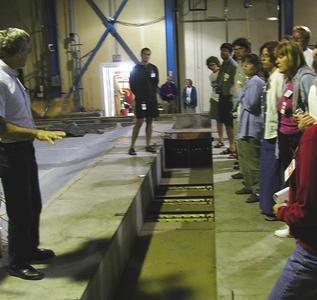
|
|
6 August, 2002
So it begins!
Tomorrow we sign our lives away. After two days of listening to veteran
TEA's and researchers of Polar Regions, we now must commit. The
responsibilities for this awesome privilege are equally awe-inspiring.
Journal writing, image recording, mentoring, doing outreach, not to mention
the role reversal of becoming a student again who will be working as a
subordinate in an alien environment at times seems almost too much to
handle. But the returning TEA's have assured us that however daunting the
task seems to be, we can do it. They did it, and would do it again if given
the chance.
As I consider this commitment, I look around at my fellow "Newbe's" (the
name given to first time TEA's) and then at the veteran TEA's and realize
they are no different than me. They may have different areas of expertise
or have a more rigorous background in a discipline, but what we share is the
over-riding factor for why we are here, we all have a thirst for extending
our own boundaries of experience and knowledge and we all want to transfer
our enthusiasm to all we come in contact with. I think this is going to be
OK. Thank you National Science Foundation!
What we are up to:
Today, we took our first field trip. It was into the facility that is
hosting us for this orientation. CRREL, Cold Regions Research and
Engineering Laboratory in Hanover, New Hampshire, is part of the Army Corps
of Engineers. This facility, as you might expect, has a number of "cold
laboratories" that are really just large freezers, some the size of a
restaurant's walk in freezer, others large enough to hold an Olympic size
swimming pool.
The pungent odor of the ammonia refrigerant mixed with the smell of curing
concrete and sawdust makes this seem like a winter construction site rather
than a research laboratory. One of the engineers, Leonard Zabilansky,
enthusiastically explained the science being done in the labs. It ranges
from determining the forces the conning tower on a submarine experiences
when surfacing through a couple of meters of ice, to developing ways to get
barges through river locks when the ice starts to build up. As we stood
around in one lab that was being cooled down to a few degrees below the
freezing point of water, it occurred to me that we will soon be having our
chance to be doing science in a rather inhospitable environment and we had
best know what we are signing up for.
So long until next time,
Andy

Leonard Zabilansky, at CRREL explains the experiment being conducted in one of the large cold rooms. They are trying to develop a way for ships to safely pass into river locks when ice becomes a problem.
Contact the TEA in the field at
.
If you cannot connect through your browser, copy the
TEA's e-mail address in the "To:" line of
your favorite e-mail package.
|
